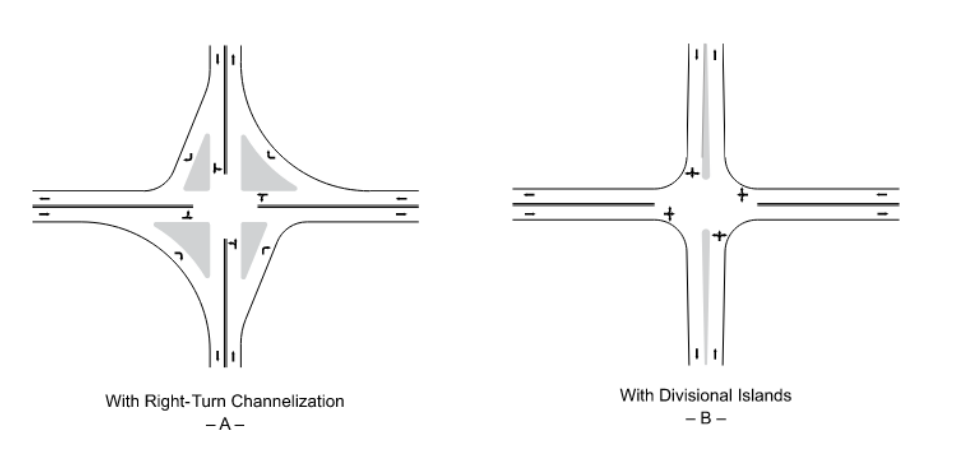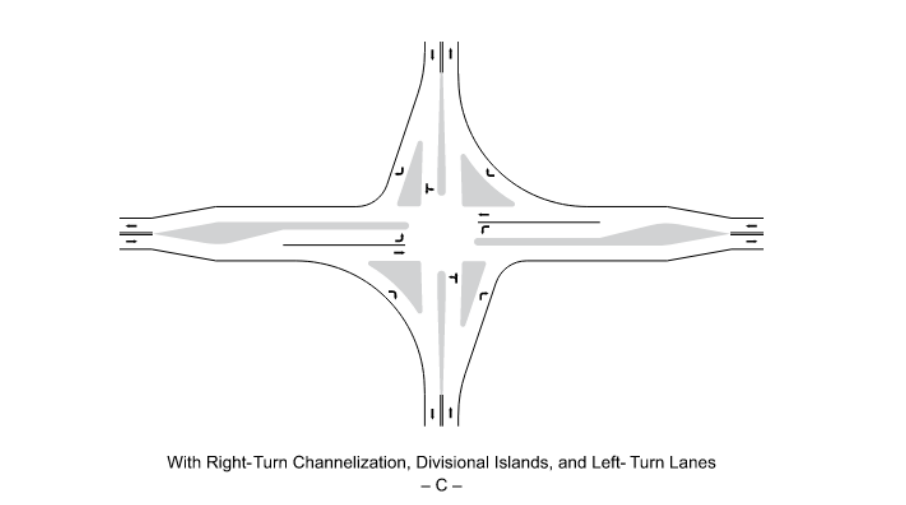13.3.2 Four-Leg Intersection
13.3.2.1 Basic Types
Basic forms of four-leg intersections are shown in
and
. Many of the design principles (e.g., island arrangements, use of auxiliary lanes, etc.) of three-leg intersection design apply to four-leg intersection design.
The simplest form of an unchannelized four-leg intersection is shown in
. This type of intersection is commonly used for intersections of minor or local roads and often used for intersection of minor roadways with major roadways.
A skewed intersection leg should not be more than 15 degrees from perpendicular.
Flared intersections, shown in
and
, provide additional capacity for through and turning movements. However, this type of intersection may create concerns for pedestrians due to higher turning speeds and longer crosswalks. Raised medians should be considered for pedestrian refuge.
Parallel auxiliary lanes (i.e., speed change lanes) should be used where traffic volume on the major roadway is near the uninterrupted-flow capacity of the roadway or where through and cross traffic volumes are sufficiently high to warrant signal control. Auxiliary lanes are also desirable for lower volume high-speed conditions.
The length of added pavement should be determined as it is for speed-change lanes (see
).
shows a flared intersection that provides right-turn lanes on the major highway. This type of configuration is suitable for two-lane roadways where speeds are high, intersections are infrequent, and the left-turning movements from the roadway could create a conflict.
F
shows a flared intersection that provides a median lane for left-turn movements. This configuration provides better protection for vehicles turning left from the major highway than the arrangement shown in
and is
better suited for intersections with signal control.

Figure 13-7: Four-leg Intersections
Source: AASHTO’s A Policy on Geometric Design of Highways and Streets
13.3.2.2 Channelized Four-Leg Intersections
Typical configurations of four-leg intersections with simple channelization are shown in
. Channelized intersections are often provided at major intersection for the more important turning movements, where large vehicles are to be accommodated and at minor intersections in quadrants where the angle of turn is substantially below 90 degrees.
shows a configuration with right-turn roadways in all four quadrants of the intersection. This configuration is suitable where sufficient space is available and right-turn volumes are high.
Divisional islands on the crossroad intersection are shown in
and fits a wide range of volumes. Its capacity is governed by the roadway widths through the intersection.
Intersections on two-lane roadways that are operating near capacity or carrying moderate volumes at high speeds should consider a configuration with channelized left-turn lanes as shown in
. The auxiliary lanes are used for speed changes, maneuvering, and storage of turning vehicles. The form of channelization on the crossroad should be determined based on the cross and turning volumes and the sizes of vehicles to be accommodated.
Refer to the
. Crosswalks at multi-lane channelized turn lanes must provide treatments consisting of one or more of the following:
- A traffic control signal with a pedestrian signal head;
- A pedestrian hybrid beacon;
- A pedestrian actuated rectangular rapid flashing beacon; or
- A raised crossing.
Older drivers have difficulty with skewed intersections due to a restricted range of motion and diminished reaction time.
Refer to the
to incorporate the following guidelines:- All intersections should meet at a 90- degree angle (applies to new facilities and redesign of existing facility where ROW is not restricted);
- Intersecting roadway should meet at an angle of no less than 75 degrees in the design of new facilities and the redesign of existing facilities where ROW is restricted; and
- Prohibiting right-turn-on-red is advisable at skewed intersections where the angle between the left approach leg and the driver's approach leg is less than 75 degrees.


Figure 13-8: Channelized Four-leg Intersections
Source: AASHTO’s A Policy on Geometric Design of Highways and Streets